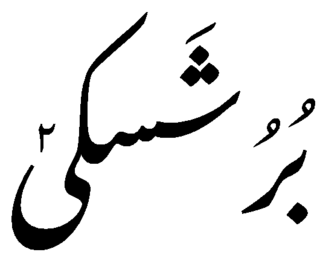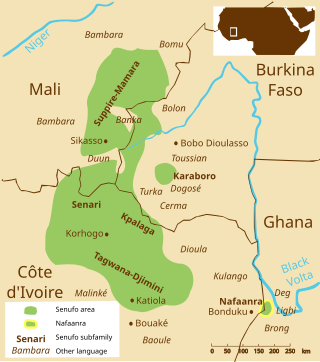Related Research Articles

Hausa is a Chadic language that is spoken by the Hausa people in the northern parts of Nigeria, Ghana, Cameroon, Benin and Togo, and the southern parts of Niger, and Chad, with significant minorities in Ivory Coast. A small number of speakers also exist in Sudan.

Niger–Congo is a hypothetical language family spoken over the majority of sub-Saharan Africa. It unites the Mande languages, the Atlantic–Congo languages, and possibly several smaller groups of languages that are difficult to classify. If valid, Niger–Congo would be the world's largest in terms of member languages, the third-largest in terms of speakers, and Africa's largest in terms of geographical area. Austronesian has almost as many member languages, although this is complicated by the ambiguity about what constitutes a distinct language; the number of named Niger–Congo languages listed by Ethnologue is 1,540.

The Senufo or Senufic languages comprise around 15 languages spoken by the Senufo in the north of Ivory Coast, the south of Mali and the southwest of Burkina Faso. An isolated language, Nafaanra, is also spoken in the west of Ghana. The Senufo languages constitute their own branch of the Atlantic–Congo sub-family of the Niger–Congo languages. Anne Garber estimates the total number of Senufos at some 1.5 million; the Ethnologue, based on various population estimates, counts 2.7 million.

The Gur languages, also known as Central Gur or Mabia, belong to the Niger–Congo languages. They are spoken in the Sahelian and savanna regions of West Africa, namely: in most areas of Burkina Faso, and in south-central Mali, northeastern Ivory Coast, the northern halves of Ghana and Togo, northwestern Benin, and southwestern Niger. A few Gur languages are spoken in Nigeria. Additionally, a single Gur language, Baatonum, is spoken in Benin and in the extreme northwest of Nigeria. Three other single Gur languages, the Tusya, Vyemo and Tiefo languages, are spoken in Burkina Faso. Another unclassified Gur language, Miyobe, is spoken in Benin and Togo. In addition, Kulango, Loma and Lorhon, are spoken in Ghana, Ivory Coast and Burkina Faso. Additionally, a few Mossi speakers are in Senegal, and speakers of the Dagaare language are also found in Cameroon. The Samu languages of Burkina Faso are Gur languages.

Burushaski is a language isolate, spoken by the Burusho people, who predominantly reside in northern Gilgit-Baltistan, Pakistan. There are also a few hundred speakers of this language in northern Jammu and Kashmir, India. In Pakistan, Burushaski is spoken by people in the Hunza District, the Nagar District, the northern Gilgit District, the Yasin Valley in the Gupis-Yasin District and the Ishkoman Valley of the northern Ghizer District. Their native region is located in northern Gilgit–Baltistan. It also borders the Pamir corridor to the north. In India, Burushaski is spoken in Botraj Mohalla of the Hari Parbat region in Srinagar. It is generally believed that the language was spoken in a much wider area in the past. It is also known as Werchikwar and Miśa:ski.

Zarma is one of the Songhay languages. It is the leading indigenous language of the southwestern lobe of the West African nation of Niger, where the Niger River flows and the capital city, Niamey, is located. Zarma is the second-most common language in the country, after Hausa, which is spoken in south-central Niger. With over 6 million speakers, Zarma is easily the most widely spoken Songhay language.

Laal is an endangered language isolate spoken by 749 people in three villages in the Moyen-Chari prefecture of Chad on opposite banks of the Chari River, called Gori (lá), Damtar (ɓual), and Mailao. It represents an isolated survival of an earlier language group of Central Africa. It is unwritten except in transcription by linguists. According to former Summer Institute of Linguistics-Chad member David Faris, it is in danger of extinction, with most people under 25 shifting to the locally more widespread Bagirmi.

Nafaanra, also known as Nafanan or Nafana, is a Senufo language spoken in northwest Ghana, along the border with Ivory Coast, east of Bondoukou. It is spoken by approximately 90,000 people. Its speakers call themselves Nafana, but others call them Banda or Mfantera. Like other Senufo languages, Nafaanra is a tonal language. It is somewhat of an outlier in the Senufo language group, with the geographically-closest relatives, the Southern Senufo Tagwana–Djimini languages, approximately 200 kilometres (120 mi) to the west, on the other side of Comoé National Park.

Supyire, or Suppire, is a Senufo language spoken in the Sikasso Region of southeastern Mali and in adjoining regions of Ivory Coast. In their native language, the noun sùpyìré means both "the people" and "the language spoken by the people".
Dagbani, also known as Dagbanli or Dagbanle, is a Gur language spoken in Ghana and Northern Togo. Its native speakers are estimated around 1,170,000. Dagbani is the most widely spoken language in northern Ghana, specifically among the tribes that fall under the authority of the King of Dagbon, known as the Yaa-Naa. Dagbon is a traditional kingdom situated in northern Ghana, and the Yaa-Naa is the paramount chief or king who governs over the various tribes and communities within the Dagbon kingdom.
Defaka is an endangered and divergent Nigerian language of uncertain classification. It is spoken in the Opobo–Nkoro LGA of Rivers State, in the Defaka or Afakani ward of Nkọrọ town and Ịwọma Nkọrọ. The low number of Defaka speakers, coupled with the fact that other languages dominate the region where Defaka is spoken, edges the language near extinction on a year-to-year basis. It is generally classified in an Ijoid branch of the Niger–Congo family. However, the Ijoid proposal is problematic. Blench (2012) notes that "Defaka has numerous external cognates and might be an isolate or independent branch of Niger–Congo which has come under Ịjọ influence."
Kusaal is a Gur language spoken primarily in northern eastern Ghana, and Burkina Faso. It is spoken by about 121,000 people and takes its name from the Kusaal people, or Kusasi. There is a distinctive dialect division between Agole, to the East of the Volta River, and Toende, to the West. Agole has more speakers. The 6-district capital; Bawku West with Zebilla as capital and the rest; Binduri, Bawku, Tempane, Garu and Pusiga districts mostly Agole dialect speakers. The complete Bible translation is in the Agole dialect.
Afrihili is a constructed language designed in 1970 by Ghanaian historian K. A. Kumi Attobrah to be used as a lingua franca in all of Africa. The name of the language is a combination of Africa and Swahili. The author, a native of Akrokerri (Akrokɛri) in Ghana, originally conceived of the idea in 1967 while on a sea voyage from Dover to Calais. His intention was that "it would promote unity and understanding among the different peoples of the continent, reduce costs in printing due to translations and promote trade". It is meant to be easy for Africans to learn.
Siwu is a language that is spoken in the mountainous central part of the Volta Region of Ghana. It belongs to the geographic group of Ghana Togo Mountain languages of the Kwa branch of Niger–Congo. The speakers of Siwu call themselves the Mawu and their land Kawu. Some of the speakers of Siwu lives around Lolobi communities.
Moro is a Kordofanian language spoken in the Nuba Mountains of South Kordofan, Sudan. It is part of the Western group of West Central Heiban Kordofonian languages and belongs to the Niger-Congo phylum. In 1982 there were an estimated 30,000 Moro-speakers. This was before the second Sudan civil war and therefore the recent number of speakers might differ. There can be noted an influence of Arabic and it is suspected that today approximately a fourth of all Moro vocabulary has a relation or an origin in the Arabic language.
Farefare or Frafra, also known by the regional name of Gurenne (Gurene), is a Niger–Congo language spoken by the Frafra people of northern Ghana, particularly the Upper East Region, and southern Burkina Faso. It is a national language of Ghana, and is closely related to Dagbani and other languages of Northern Ghana, and also related to Mossi, also known as Mooré, the national language of Burkina Faso.
The Mampruli language is a Gur language spoken in northern Ghana, Northern Togo, Burkina Faso, Ivory Coast and Mali by the Mamprusi people. It is partially mutually intelligible with Dagbani. The Mamprusi language is spoken in a broad belt across the northern parts of the Northern Region of Ghana, stretching west to east from Yizeesi to Nakpanduri and centred on the towns of Gambaga, Nalerigu and Walewale.
Jibu is a Jukunoid language spoken in the Taraba State of Nigeria by 30,000 people.
Chakali (tʃàkálɪ́ɪ́) is a Gur language of Ghana, spoken by almost 3,500 individuals in several villages in the Wa East District of the Upper West Region. More specifically, Chakali is spoken by inhabitants of the Tiisa, Sogla, Tousa, Motigu, Ducie, Katua and Gurumbele villages. The majority of Chakali speakers also speak Wali or Bulengi. Some believe that the language of Chakali is soon to be extinct, with Wali and Bulengi becoming the only languages that will be spoken in those villages.
Tony Naden is a British lexicographer who specializes on Western Oti-Volta subgroup of Gur languages. He has compiled dictionaries in the following languages: Dagbanli, Mampelle, Mõõré, Nabt, Talene, KaMara and Yarsi.
References
- Blench, Roger (2003). "Plural verb morphology in Vagla" (PDF). Cahiers Voltaïques. 6: 17–31. Archived (PDF) from the original on 20 April 2015. Retrieved 31 August 2024.
- Crouch, Marjory; Naden, Anthony (1998). "A semantically-based grammar of Vagla". Gur Papers (Special issue I). Bayreuth: University of Bayreuth. OCLC 174505065.